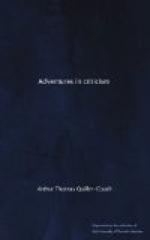The assumption of many critics that only within the metropolitan cab radius can a comprehensive system of philosophy be constructed, and that only through the plate-glass windows of two or three clubs is it possible to see life steadily, and see it whole, is one that I have before now had occasion to dispute. It is joined in this case to another yet more preposterous—that from a brief survey of an author’s circumstances we can dictate to him what he ought to write about, and how he ought to write it. And I have observed particularly that if a writer be a countryman, or at all well acquainted with country life, all kinds of odd entertainment is expected of him in the way of notes on the habits of birds, beasts, and fishes, on the growth of all kinds of common plants, on the proper way to make hay, to milk a cow, and so forth.
Richard Jefferies.
Now it is just the true countryman who would no more think of noting these things down in a book than a Londoner would think of stating in a novel that Bond Street joins Oxford Street and Piccadilly: simply because they have been familiar to him from boyhood. And to my mind it is a small but significant sign of a rather lamentable movement—of none other, indeed, than the “Rural Exodus,” as Political Economists call it—that each and every novelist of my acquaintance, while assuming as a matter of course that his readers are tolerably familiar with the London Directory, should, equally as a matter of course, assume them to be ignorant of the commonest features of open-air life. I protest there are few things more pitiable than the transports of your Cockney critic over Richard Jefferies. Listen, for instance, to this kind of thing:—
“Here and there upon the bank wild gooseberry and currant bushes may be found, planted by birds carrying off ripe fruit from the garden. A wild gooseberry may sometimes be seen growing out of the decayed ‘touchwood’ on the top of a hollow withy-pollard. Wild apple trees, too, are not uncommon in the hedges.
“The beautiful rich colour of the horse-chestnut, when quite ripe and fresh from its prickly green shell, can hardly be surpassed; underneath the tree the grass is strewn with shells where they have fallen and burst. Close to the trunk the grass is worn away by the restless trampling of horses, who love the shade its foliage gives in summer. The oak apples which appear on the oaks in spring—generally near the trunk—fall off in summer, and lie shrivelled on the ground, not unlike rotten cork, or black as if burned. But the oak-galls show thick on some of the trees, light green, and round as a ball; they will remain on the branches after the leaves have fallen, turning brown and hard, and hanging there till the spring comes again.”—Wild Life in a Southern County, pp. 224-5.
I say it is pitiable that people should need to read these things in print. Let me apply this method to some district of south-west London—say the Old Brompton Road:—




